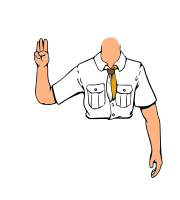
Scouting, also known as the Scout Movement, is a worldwide youth social movement employing the Scout method, a program of informal education with an emphasis on practical outdoor activities, including camping, woodcraft, aquatics, hiking, backpacking, and sports. Another widely recognized movement characteristic is the Scout uniform, by intent hiding all differences of social standing in a country and encouraging equality, with neckerchief and campaign hat or comparable headwear. Distinctive uniform insignia include the fleur-de-lis and the trefoil, as well as merit badges and other patches.

Junák – český skaut, is the internationally recognized organization of Scouts and Guides of the Czech Republic. Founded in 1911, Junák – český skaut is the largest organisation of children and youth in the nation, with a membership of 73,315.
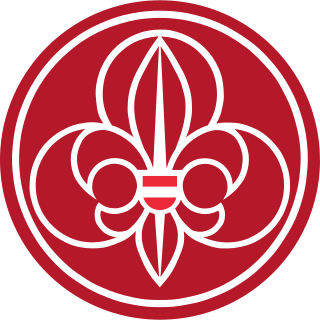
Pfadfinder und Pfadfinderinnen Österreichs is the largest Scouting and Guiding organization in Austria and the only one approved by World Association of Girl Guides and Girl Scouts (WAGGGS) and the World Organization of the Scout Movement (WOSM). The association claims more than 300 troops with more than 85,000 Scouts nationwide. WOSM and WAGGGS give quite smaller membership values for the PPÖ: 27,274 members in WOSM and 10,508 members in WAGGGS.

The Association of Scouts of Azerbaijan the national Scouting organization of Azerbaijan, was founded in 1997, and became the 150th member of the World Organization of the Scout Movement on 20 August 2000. In 2017 it was admitted as a full member in the World Association of Girl Guides and Girl Scouts. The coeducational association has 1,571 members as of 2021, about 35% are girls.
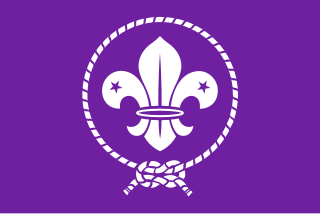
The European Scout Region is one of six geographical subdivisions of the World Organization of the Scout Movement, headquartered in Geneva, Switzerland, with a satellite office in Brussels, Belgium.

Lietuvos skautija, the primary national Scouting organization of Lithuania, became a member of the World Organization of the Scout Movement in 1997. The coeducational Lietuvos skautija has 1,446 members as of 2012.

Sojuz na Izvidnici na Makedonija (The Scout Association of Macedonia) (Macedonian: Сојуз на извидници на Македонија), the national scouting organization of Republic of North Macedonia, became a member of the World Organization of the Scout Movement in 1997. The coeducational Sojuz na Izvidnici na Makedonija has 2140 members as of 2016.
The Scout movement in Yugoslavia was served by different organizations during the existence of the multi-ethnic state.

Scouting Nederland is the national Scout organisation of the Netherlands with approximately 110,000 members (53,324 male and 54,663 female, 87,000 youth members, as of 2010.
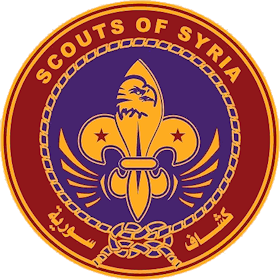
Scouts of Syria is the national Scout and Guide organization of Syria. Scouting in Syria was founded in 1912; Guiding started in the 1950s. The coeducational association serves 9,358 members and is a member of both the World Organization of the Scout Movement and the World Association of Girl Guides and Girl Scouts.

Gidsen- en Scoutsbeweging in België (Dutch) or Guidisme et Scoutisme en Belgique (French) (GSB) is the national Guiding and Scouting federation in Belgium. Scouting in Belgium started in 1911, and Guiding followed in 1915. The Belgian Scouts were among the charter members of the World Organization of the Scout Movement (WOSM) in 1922, and the Guides were one of the founding members of the World Association of Girl Guides and Girl Scouts (WAGGGS) in 1928. The federation counts 121,600 Scouts and 59,268 Guides.

Pfadfinder und Pfadfinderinnen Liechtensteins is the national Scouting and Guiding association of Liechtenstein. Scouting in Liechtenstein started in 1931, and Guiding followed in 1932. The Boy Scouts became a member of the World Organization of the Scout Movement in 1933, and the Guides joined the World Association of Girl Guides and Girl Scouts in 1952. In 1989 both organizations merged and formed the present Pfadfinder und Pfadfinderinnen Liechtensteins. The PPL has about 1,100 members of both sexes and is organised in ten troops.
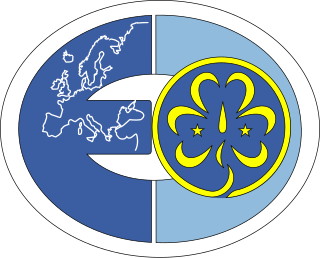
The WAGGGS Europe Region is the regional office of the World Association of Girl Guides and Girl Scouts, which supports Girl Guiding and Girl Scouting in Europe, including the former Soviet Republics of Armenia, Azerbaijan, Belarus, Georgia, Moldova, Russia, and Ukraine, as well as Cyprus and Israel.
The Scout Movement of Romania consists of several associations with slightly different aims. Among them are:

Savez Izviđača Crne Gore is the national Scouting organization of Montenegro. A referendum on independence was held in Republic of Montenegro on May 21, 2006, voting to leave its state union with Serbia by a narrow margin. Montenegro became the world's 192nd recognized sovereign state, which then split the Savez Izviđača Srbije i Crne Gore, as happened with Czechoslovakia in 1993, meaning that Savez Izviđača Crne Gore had to reapply for World Organization of the Scout Movement membership in 2008.

Savez Izviđača Srbije, English: Scout Association of Serbia) is the primary national Scouting organization of Serbia. A referendum on independence was held in Montenegro on May 21, 2006, voting to leave its state union with Serbia by a narrow margin. Montenegro became the world's 193rd recognized sovereign state, which has then split the Savez Izviđača Srbije i Crne Gore, as happened with Czechoslovakia in 1993, meaning that the membership in the World Organization of the Scout Movement was transferred to Savez Izviđača Srbije.

The Nigerian Girl Guides Association is the national Guiding organization of Nigeria. It serves 113,726 members. Founded in 1919, the girls-only organization became a full member of the World Association of Girl Guides and Girl Scouts in 1966.
The Scout and Guide movement in Slovakia is served by
The Scout and Guide movement in Jamaica is served by

The Bund der Pfadfinderinnen und Pfadfinder (BdP) (German Association of Guides and Scouts) is the largest non-denominational, co-educational Scout and Guide association in Germany. Through its membership in the Ring deutscher Pfadfinder*innenverbände, it is part of the World Organization of the Scout Movement and the World Association of Girl Guides and Girl Scouts. Founded in 1976, the association serves about 30,000 members nationwide.


